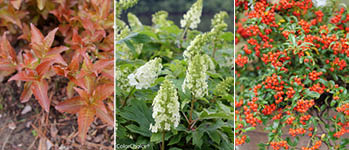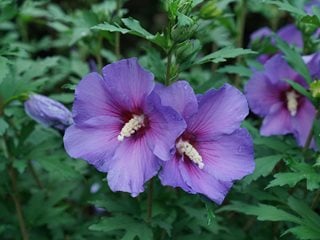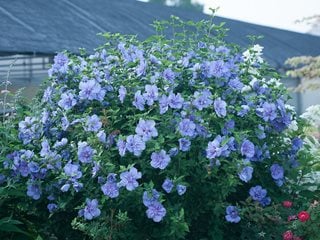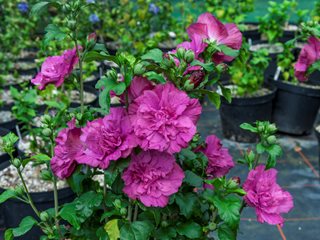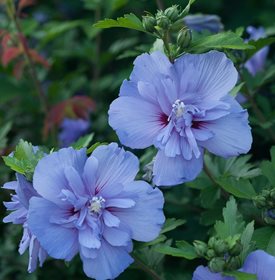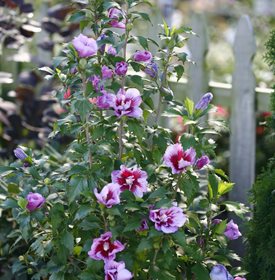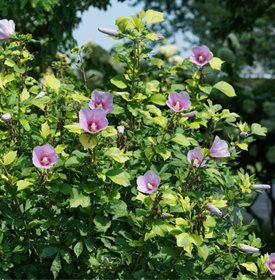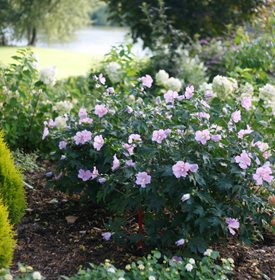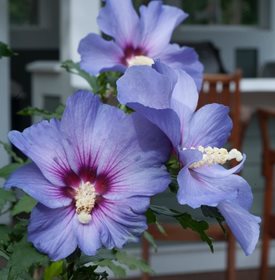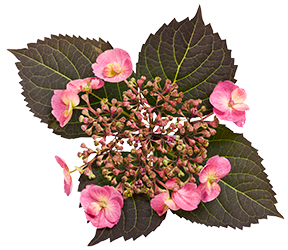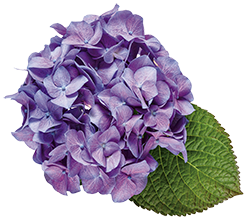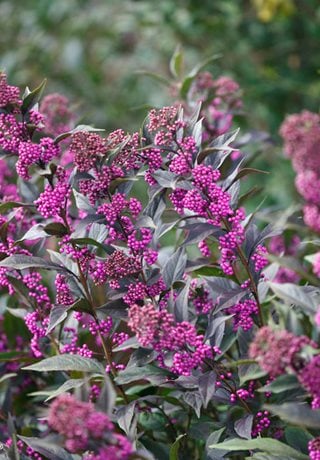Rose of Sharon Growing Guide
Bring the tropics to your garden with Hibiscus syriacus that can overwinter even in temperatures below zeroHibiscus plants aren’t only for the tropics. In fact, some hardy hibiscus varieties, like the popular rose of Sharon, can overwinter outdoors in temperatures as cold as 20° below zero.
On this page: Basics | Planting | Care and Maintenance | Pictures | Design Ideas | Is rose of Sharon invasive?
On this page:
Buy rose of Sharon plants from Proven Winners.
BASICS
Botanical name:
Hibiscus syriacus
Common names:
Rose of Sharon, shrub althea; also shares the common name hardy hibscus with Hibiscus moschuetos.
Zones:
Generally 5-9, with some exceptions.
Height/Spread:
8 to 12 feet tall, 6 to 10 feet wide, depending on the variety
Exposure:
Full sun to partial afternoon shade (best flowering in full sun).
Soil:
Prefers moist, yet well-drained soil; mulch to help retain moisture.
Bloom Time:
Rose of Sharon bushes start blooming in July and continue into fall or until the first frost.
Flower Color:
Shades of white, pink, red, and purple; sometimes with a contrasting throat.
Foliage:
Deciduous; with medium-green, heart- or maple-shaped leaves, although there are a few exceptions.
PLANTING
When to plant:
Rose of Sharon plants and other hardy hibiscus varieties can be planted in spring or fall, as long as there is no danger of frost.
Where to plant:
Full sun to partial afternoon shade. An area with good air circulation produces the best flowers and strongest stems, and is the best environment to prevent disease. Keep an eye out for hot, scorching afternoon sun that may burn the foliage; as well as provide protection from damaging wind.
How to plant:
Seeds can be started indoors and then transplanted, but it is more common to plant potted plants purchased from a nursery. Dig a hole twice the width of the pot and set the plant in. Make sure the crown of the plant rests just at or above the soil line. Backfill the hole, and water well.
CARE
Fertilizer:
Hibiscus need a fertilizer high in potassium (K), low in phosphorus (P), and with a medium amount of nitrogen (N)—too much phosphorus will kill a hibiscus. Hibiscus also respond well to an organic fertilizer, and a good layer of compost once a year is generally sufficient. Don’t fertilize after July as this can push new growth that will be damaged by frost.
Water:
They prefer moist soil and do not tolerate drought. Water regularly and up to twice a day in hotter weather, especially if in a container. Cut water back a bit in colder weather. Water-stressed hibiscus may drop their buds or become more susceptible to insects and disease. They should not be left in standing water as this can promote root damage/root rot.
Pruning:
Little pruning is required, and is generally only needed to maintain appearance, size, and shape. They can be cut back 4-6 inches from the ground in spring, anytime before the new growth emerges. Pruning before very cold temperatures or in extreme heat can be very stressful to your plant and do more harm than good.
Tip pruning can stimulate branching, and since more branching means more flowers, a little trim late spring to early summer can be a good thing.
Deadheading:
To help prevent an over-abundance of seed pods from forming (some varieties may re-seed abundantly). (Or, for a similar look, try the non-seeding Summerific® series rose mallows.)
Overwintering:
Hardy varieties will die back to the ground in the winter in colder regions, but new growth will develop from the roots in mid to late spring from the root tops. In colder climates, cover the root ball with mulch to insulate it.
Diseases and Pests:
Hardy hibiscus can fall prey to a number of pests, including Japanese beetles, whiteflies, aphids, and ants. Ants can be more than a mere annoyance on your hibiscus, as they will actually bring aphid eggs to the hibiscus so that they can feed off of the byproducts the aphids produce from sucking the sap from the leaves and flowers. Hibiscus may be susceptible to dieback disease, wilt disease, and leaf fungus.
HIBISCUS PICTURES
Featured in: Garden Design's Top 10 Garden Trends for 2022 ("Including Plants that Transport You to the Tropics")
DESIGN TIPS
- Excellent foundation plant, anchoring structures to the landscape; planting close to buildings also provides some cold protection for the plant.
- Hibiscus are some of the most colorful plants in the landscape, so be careful not to overwhelm an area or have clashing tones.
- Generally grown as multi-trunked shrubs, rose of Sharon can also be trained as a single-trunk small tree or espalier.
- Hardy hibiscus are not good for cut flowers, as their blooms only last a day or two. Dried seed pods can provide an exotic look and last longer in an arrangement.
IS ROSE OF SHARON INVASIVE?
Hibiscus syriacus can be invasive in the following areas:
- Most of Indiana
- Parts of the South
- Coastal areas of the Mid-Atlantic
To see if rose of Sharon has been identified as invasive in your area check out this map from InvasivePlantAtlas.org.
If concerned, try seedless varities such as Sugar Tip® and Azurri Blue Satin®, or nearly seedless Pollypetite®.
Related:
Growing Rose Mallow (Swamp Hibiscus)
Tropical Hibiscus Growing Guide
Flowering Shrubs
Tropical Gardens
